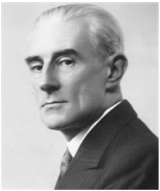
Debussy vs. Ravel
Laurel and Hardy, Abbott and Costello, Penn and Teller, Debussy and Ravel…two names that always seem to go together, right? And yet Debussy and Ravel were very different composers, with diverging aesthetics and views on music and life. In this special addition to Conductor’s Corner, I review the two composers and their lives, as well as their outlook on art, successes, works, and personal thoughts on life and art. Enjoy!

CLAUDE DEBUSSY
MAURICE RAVEL
BORN
1862
1875
DIED
1918
1937
ANCESTRY
French
Father:Swiss
Mother:French Basque (area near the Spanish Border)
EDUCATION
Paris Conservatory 1872-1887 Wins Prix de Rome 1884 with his cantata L’enfant prodigue. Teachers include Marmontel (piano) and Guiraud (composition)
Paris Conservatory 1889-1905. Tries five times to win Prix de Rome—NOT successful. Teachers include Gabriel Fauré and Andre Gedalge (composition and counterpoint)
INSTRUMENT
piano
piano
MUSICAL AIMS & AESTHETICS
Wanted to create a music free from traditional academic rules, as well as create an antidote to the heavy Wagnerian influence dominant in France at that time. Was Symbolist in outlook: vagueness, understated, discrete
Stated musical aim was “technical perfection”. Sought to create highly polished works of the utmost perfection (hence his relatively small output). Stravinsky called him “The Swiss Watchmaker”. Favored conciseness and clarity.
INFLUENCES
Wagner, Palestrina (from stay in Rome), non-Western musical influences (such as gamelan, from 1889 World Expo in Paris), Russian Nationalist composers (especially Mussorgsky), Chopin
Mozart (his idol, revered above
ALL other composers), Chopin, non-Western musical influences, Liszt, Russian nationalist composers, Chabrier, Satie
HARMONY
Used static harmony, diatonic saturation, chromatic mediants, modal scales, pentatonic scales, whole-tone scales, tritone relationships (VERY important in Debussy: they help break down the tonal system), non-functional coloristic harmony, high tertian harmony
Many of the same characteristics as Debussy, who influenced Ravel greatly (Debussy was 13 years his senior), but also including the following:
---jazz harmony and idioms
---bitonality
---exceedingly complex tertian harmony (altered)
FORM
Hated traditional form and sought new forms for many of his works. Only late in life did he return to some of the standard forms (highly modified)
Used the accepted and inherited musical forms (sonata, concerto, etc). Was essentially a “miniaturist”
ORCHESTRATION
Highly individual. Unusual combinations of instruments and colors. Completely without precedent.
Regarded as one of the supreme orchestrators of the 20th century or ANY century. Was influenced by Richard Strauss. Brilliant orchestration, bright, exceedingly virtuosic.
TYPICAL QUOTE
“I love music passionately, and because I love it I try to free it from barren traditions that stifle it.” “Discipline must be sought in freedom….Give ear to no man’s counsel but listen to the wind that tells in passing the history of the world.”
“There are in fact two types of music: that which pleases and that which is boring.”“Complex but not complicated” “My own music is, quite simply, nothing but Mozart.”
AWARDS
French Legion of Honor
(accepted it)
French Legion of Honor
(refused it)
FIRST GREAT INTERNATIONAL SUCCESS
Afternoon of a Faun, first performed in 1894
L’Heure espagnole (The Spanish Hour)
opera—first performed in 1911
DIVISIONS OF CREATIVE OUTPUT
early works up to 1900 (Nocturnes for Orchestra, 1900)
middle period of greatest achievements, including Pelleas et Melisande, La Mer, etc. 1901-1911
late period 1912-18, most advanced experimental writing (Jeux, ballet, 1912)
1900-1920: from early works through Daphnis et Chloe. Lush, rich music. Large orchestras, splashy color
1922-1931 a leaner, more LINEAR approach to writing, more austere, economy of means. Use of jazz, bitonality, reduced orchestration
CAUSE OF DEATH
Rectal Cancer
Ataxia (inability to coordinate voluntary muscular movements), and aphasia (difficulty in speech and a partial loss of memory) leading to a delicate brain operation in 1937 which induced a semi-coma from which he never awoke
IMPORTANT WORKS: Operas
Pelleas et Melisande (1902)
L’Heure espagnole (1911 fp)
L’Enfant et les Sortileges (1925)
IMPORTANT WORKS: Orchestra
Prelude to the Afternoon of a Faun (1894)
Nocturnes (1900)
La Mer (1905)
The Martyrdom of St. Sebastien (incidental music) (1911)
Images (1905-1912)
Rapsodie espagnole (1907)
Pavane (1910)
Daphnis et Chloé Suite 1 (1911)
Mother Goose Suite (1911)
Daphnis et Chloé Suite 2 (1913)
Alborada del gracioso (1918)
Le Tombeau de Couperin (1919)
La Valse (1919-1920)
Boléro (1928)
IMPORTANT WORKS: Ballet
Jeux (1912)
Daphnis et Chloé (1912)
IMPORTANT WORKS: Concertos
Premiere Rhapsody for Clarinet and Orchestra (1911)
Sacred and Profane Dances for Harp and String Orchestra (1904)
Piano Concerto for the Left Hand (1930)
Piano Concerto in G Major (1931)
IMPORTANT WORKS: Chamber
String Quartet (1893)
Three late Sonatas for mixed instruments (1915-17)
String Quartet (1903)
Introduction and Allegro for Harp, flute, clarinet and string quartet (1905)
Piano Trio (1914)
Sonata for Violin and Cello (1922)
Violin Sonata (1927
IMPORTANT WORKS: Piano
Suite bergamasque (1890)
Pour le Piano (1901)
Estampes (1903)
Images (1905)
Children’s Corner (1908)
Preludes (Book 1: 1910 Book 2: 1913)
Etudes (1915)
Jeux d’eau (1901)
Sonatine (1905)
Miroirs (1905)
Gaspard de la nuit (1908)
Le Tombeau de Couperin (1917)
IMPORTANT WORKS: Songs
MANY songs and some important cycles
MANY songs and some important cycles
WORK GENERALLY ACCEPTED AS GREATEST MASTERPIECE
Pelleas et Melisande
Daphnis et Chloé (1912)
